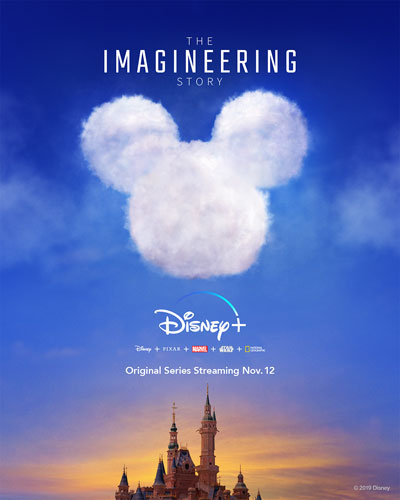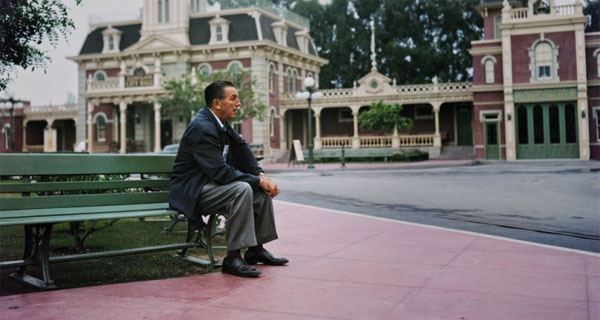
It’s easy to predict the stories you’ll hear in a show about Walt Disney Imagineering (WDI). Clips of Walt Disney talking about inspirations for Disneyland will appear. We’ll also see scenes on the creation of the Enchanted Tiki Room, Pirates of the Caribbean, and the Carousel of Progress. That’s just the framework for moments of pure magic, however. The Imagineering Story (available now on Disney Plus) hits the broad strokes we expect, but it’s the heart that really makes it special. What sticks with you are the small, emotional moments that remind us why we love the parks.
The prime example comes from the wonderful Bob Gurr, who takes us inside The Matterhorn. He shoots a basket on the infamous court inside the mountain and talks about designing the ride system. Beyond the backstage view, what I loved was seeing the emotions on Gurr’s face when Director Leslie Iwerks asks if he wants to sign his name by the others inside The Matterhorn. You can see the affection that Gurr has for Disneyland and what he created working for Walt. This brief moment gives me chills and reveals how this TV series is more than a basic history.
When I opened the Disney Plus app Wednesday, my first destination was The Imagineering Story. It offers us a chance to experience the history of WDI directly from the key figures involved. Many of the original Imagineers at WED have passed away, but archival footage offers them a voice to tell their stories. Along with legendary figures like Gurr and Rolly Crump, we hear from Herb Ryman, X Atencio, Harriet Burns, Harper Goff, and more. Angela Bassett’s powerful voice narrates the story, which should please both Disney fanatics and more casual viewers.

Curiosity of a Middle-Aged Child
There’s a certain gleam in Walt’s eyes when he talks about plans for Disneyland. You can see it when he’s looking at the artwork and model on his TV show; the phrase “curiosity of a middle-aged child” fits him perfectly. That term also describes so many of us when we visit the parks. During this episode, Walt relays the familiar story of taking his daughters to a merry-go-round on “Daddy’s Day”. It’s a simplified tale to frame the park, but the story explains the key idea of adults and kids playing together. He essentially created a new industry, and I appreciate the brief look at how other vendors adjusted their approaches based on Disneyland.
Walt led the charge, but his Imagineers made the dreams a reality. Tony Baxter describes this group as a “great orchestra”, and the clip of everyone messing with sounds is a perfect complement. This show reinforces Walt’s greatness but expands the scope beyond the legend. John Hench’s design expertise gets the first mention of a key skill. The story moves quickly, but Iwerks ensures we learn about the key players. A remarkable photo of the original Imagineers with the names identified reminds of lesser-known figures along with the famous ones.
Bassett describes big achievements in Disneyland’s early days, including the Jungle Cruise. Stunning footage of Harper Goff driving a station wagon through the dry lagoon confirms the ingenuity. I love the chance to see clips that are entirely new to me throughout this episode. A ridiculous scene of animatronic pirates riding down the highway on a back of a truck is a classic. The Imagineering Story reminds us of just how odd Disney attractions can be when taken in a different context. The segment on Lincoln going into spasms falls into a similar category.
Black Sunday
The chaos of July 17, 1955 has become legend by now among Disney fans. Between the plumbers’ strike, counterfeit tickets, and extremely hot weather, the situation was rife for disaster. Dick Nunis was there for the whole mess, and it’s great to hear his perspective. Gurr also describes the chaos when kids jumped the lines and just grabbed cars on the Autopia. It’s hard to picture that scene compared to the controlled set-up in today’s park. The clips from “Black Sunday” are funny given Disneyland’s massive popularity now.
I’m glad this series reinforced the risks to Disney if the projected failed. Sklar explains that Disney would likely have shut down without its success. Even something costly like Galaxy’s Edge today has none of that danger to the company. Disneyland is part our consciousness now, but the obstacles were huge at the start. I still can’t believe how quickly it was constructed; single attractions take several years today. Given all the issues, the accelerated pace probably was an unwise idea. Even so, the park eventually thrived and expanded rapidly.
Why was Disneyland so different? Tom Morris explains the brilliant hub-and-scope concept and its connection to the layout of Paris. Kim Irvine describes the weenie idea and how it helped with crowd flow through the lands. I know that Disney sometimes overstates the idea of the park as a movie, but it was a real thing in the design. Tom Fitzgerald illustrates this cinematic approach, which made guests part of the story. All of these examples in The Imagineering Story reveal how Walt and the Imagineers overcame the early obstacles to create such a brilliant park.

We’re Just Getting Started
I’m still amazed at how much Disneyland changed during its early years. In particular, the additions of the Matterhorn, Monorail, and the subs all in 1959 is a crazy expansion. Tomorrowland had become a “world on the move” like Morris explains, and the park just kept getting better. We quickly move through major developments like the Tiki Room and the 1964 World’s Fair attractions, with clear vintage footage of each attraction. The segment on “it’s a small world” about Alice Davis, Mary Blair, and Rolly Crump is a highlight. Richard Sherman appears to play the song, and it reminds us of how much talent and artistry went into this classic boat ride.
Another favorite is the clip of Marty Sklar standing inside Pirates of the Caribbean with the animatronics moving slowly around him. He rightfully confirms that Pirates is the standard upon which all other attractions are judged. This section also presents amazing drawings and photos from Marc Davis that led to the classic sight gags. Eddie Sotto aptly describes the slow build-up and sense of anticipation that makes Pirates succeed. There is a reason that the Florida version never reaches the same peak as the California original. The extra time builds the momentum.
This episode’s final act reminds us of the impact Walt had on everyone at Disney. Seeing Crump and Gurr both tear up when talking about his passing was emotional for me as a viewer. Baxter describes arriving
at Disneyland on that day and the sadness everywhere. More than 50 years have passed since Walt died, but his impact still resonates with all of us. The Imagineering Story reminds us of more than just Walt’s magical creations; we see the human impact. The tragic loss remains with the Imagineers, but they were just getting started.



Loved the show. I see the EPCOT one is ready.
The thought that all these people created Disneyland out of their mind-body-soul – no computers, no internet – just their own educations and creative talent – is what amazes me.
I watched part of the 1st MM Club this morning – I was 4 years old in 1955. We were inspired by Disney even with something as playful as this. He took us around the world and so many other places that were fun and opened our horizons. I feel so lucky to be alive during the Disney years.
Debbie, I can’t wait to watch the Epcot episode. That’s such an interesting time in Disney’s history! They really tried to find a way to make EPCOT the city, but between the gasoline shortage and challenges of creating a city, it was too much. You make a great point about the lack of computers and The Internet. Even with Epcot, when I think about the limited computing power they used to make those Future World attractions, it’s astounding. I grew up in the ’80s but saw a lot of the older Disney shows on The Disney Channel when I was younger. They used to show a lot of that in the early days. I definitely want to go back and watch the ones that are available on Disney Plus.